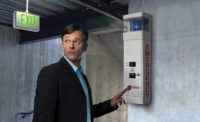LIFE SAFETY
Go Above & Beyond for Effective Emergency Communication/Notification
Gone are the days when emergency communication just meant going to a fire panel and making an announcement over the public address system. With today’s technology options, why not take advantage of all the possibilities?

IMAGE COURTESY OF AIPHONE
Emergency communications towers are common sites on college campuses today, and increasingly universities are seeking even more ways to protect and alert students and staff to emergencies.

IMAGE COURTESY OF HONEYWELL
Honeywell’s UNP enables efficient sharing of information during situations by taking siloed systems in a building and allowing them to communicate with each other to prioritize and push out to building occupants both on and off premises.

IMAGE COURTESY OF ZENITEL
When it comes to audio devices, the role of intelligibility is critical to ensure the message can be both heard and understood in the environment.

IMAGE COURTESY OF SHARE911
Many new solutions recognize the need not only to disseminate information, but to receive it using two-way communication.




If you want to see how far technology has come with emergency communication and notification capabilities, look no further than Virginia Tech, a university campus that experienced two shooting events. The first, in April 2007, left 32 people dead. During that event, it took several hours to alert everyone on campus. When another unfortunate event occurred a few years later, the campus — which had instituted a multi-layered approach to notification after the 2007 tragedy — was better prepared, says Doug Hoeferle, global offering leader for building communications, Honeywell Building Technologies, Atlanta.
“The first Virginia Tech shooting took four hours to notify everyone on campus. The second one … the entire campus was notified within 30 minutes,” Hoeferle says. That event resulted in two deaths — a police officer and the shooter. While any loss of life is tragic, Hoeferle points to improvements in technology, integration and “layering” as the key to keeping as many people safe as possible, whether the event is a mass shooting, fire or weather event. “They used eight layers, including social media,” he says.
Others, from manufacturers to code-defining bodies such as the National Fire Protection Association, also have recognized the potential of technology to alert in a variety of ways, from traditional lights and sounders, to SMS text notification, to taking over computers and signage, to the use of video and social media. With the proliferation of companies that offer solutions, it can be challenging to know what is best for the customer. But one thing is certain: There is a growing need and desire for these types of systems; and if you understand what the capabilities are and how best to incorporate them into the customer’s overall emergency protocols, they can and will save lives.
New Technologies
Some of the mass notification solutions today might surprise you. For example, Speco, a company based in Amityville, N.Y., known for its video surveillance products, recently introduced its solution, which incorporates video along with other technologies. “Being in the business of safeguarding lives and property, we continually ask ourselves what other ways we can use video to prevent and mitigate the harms from new threats such as increasing active shooter situations, more frequent fires, as well as other forms of destruction such as extreme weather,” says James Hoang, partnering and integration manager, Speco Technologies. “That is why Speco has developed our SecureGuard SMS Mass Notification System.”
Speco’s solution integrates the company’s video technology with partner technologies including gunshot detection sensors, facial recognition, and license plate recognition. “When a Speco video system detects a threat, be it from a face on a wanted list, a stolen car or a gunshot, Speco can send text alerts to hundreds of different mobile devices within seconds to get people out of harm’s way,” Hoang explains.
Text messaging also combines with video in Rave’s latest feature to its Rave Alert solution that allows organizations to send unlimited messages to unlimited recipients. “Earlier this year we released a live stream video feature for the Rave 911 suite,” says Noah Reiter, vice president of customer success, Rave Mobile Safety, Framingham, Mass. “The feature enhances public safety officials’ ability to communicate, assess emergency situations, better deploy critical resources, collaborate and make more informed decisions during an event with real-time critical information.”
Many new solutions recognize the need not only to disseminate information, but to receive it using two-way communication. Share911, for example, enables security directors and managers to notify employees of operations and safety concerns at or near a workplace, says Erik Endress, CEO of Share911, Ramsey, N.J. “Unlike traditional mass notification platforms, Share911 Notify enables employees to acknowledge the receipt of the notification and reply with any information they may have about the situation,” he explains.
Code Updates on Mass Note & EC
Many mass notification and emergency communication systems are tied to fire and life safety systems, which are code-driven and enforced by local AHJs. Recent NFPA code revisions take into account non-fire events and mass notification situations, allowing the latter to occasionally override the fire system (for example, an active shooter scenario where the shooter pulls the fire alarm to try to evacuate the building). In addition, active shooter situations themselves have a new code just for that situation. But every state and jurisdiction is different and states and counties often have their own rules based on national standards. For this reason it is critical to stay up-to-date on the latest codes and changes, as well as know your local code and AHJ.
“Across the U.S., each state has a different way of looking at the regulatory portion of NFPA,” says Biamp’s Mike Cast. “For integrators it can be challenging to get a clear understanding about what portion of NFPA is in effect and what they enforce. It’s our mission to be a resource for integrators and to help them understand what a particular region’s AHJ views are on NFPA.”
One of the most recent regulation changes integrators have been asking him about, Cast adds, is NFPA 3000, which is the current active shooter and hostile event standard. “Active shooter has been a very unfortunate and [frequent] conversation due to many events in the U.S.,” he says. “NFPA 3000 is currently the only mandated guideline for that,” he says.
NFPA 3000 Standard for an Active Shooter/Hostile Event Response (ASHER) establishes best practices for organizing, managing and sustaining an active shooter preparedness and response program, says Sielox’s Karen Evans. “It addresses all aspects of the process in developing a program, from identifying hazards and assessing vulnerability, to planning, resource management, incident management, first responder competencies and recovery. Failure to establish an ASHER program based on NFPA 3000 can be considered a breach of duty and [negligence] in the event of an incident.”
NFPA 72 also has a recent and important change affecting mass notification and emergency communication, says Honeywell’s Doug Hoeferle. “A few years ago, nothing could override a fire alarm system, but that changed recently. Now it is based on risk assessment and a non-fire event like an active shooter or terrorism can override it. It is pretty new, so not all integrators may be aware of it.”
Hoeferle advises, however, not to be too restricted by codes. As long as you are meeting code, it is OK to exceed it, he says. “We see typically there is a fairly conservative approach to codes and almost a fear to do anything outside of code. That could cause a sub-optimal situation where you are maybe only providing one layer of communication instead of eight.”
Designed for school security applications, Crisis Lockdown Alert Status System (CLASS) from Sielox also relies on two-way communication. “We are continually enhancing CLASS with new and more powerful features; for example, CLASS can be accessed anywhere and anytime ... A chat feature enables two-way communications between occupants and first responders to exchange detailed information or instructions,” says Karen Evans, CEO, Sielox LLC, Runnymede, N.J. “CLASS can also issue messages with response instructions specific to each alert level … and override any PC on the network to ensure the highest visibility of alert status.”
Two-way communication is critical to the Command & Control Incident Management System (C2) from BluePoint Alert Solutions (an Emergency24 strategic partner), Elgin, Ill., says John Shales, co-founder. “Our solution is founded on the idea of we keep an emergency from becoming a tragedy? We believe empowering people with greater situational awareness quickly and intuitively is the path to reducing and minimizing tragedy. Our latest development addresses the problem of quickly accounting for people during an armed intruder event … It not only enables people to report their location, but also provide a means to report medical needs, as well.”
The key to the most effective emergency communication and mass notification is often not one solution, but the combination of technologies, Hoeferle says. Many solutions can and should be integrated into an overall security and life safety system, for the most effective and multi-layered approach.
That is why Honeywell is introducing a mass notification platform solution called UNP, unified notification platform. “Most of our systems are at least integrated with the fire alarm system,” he says. “[UNP] enables efficient sharing of information during situations by taking siloed systems in a building and allowing them to communicate with each other to prioritize and push out to building occupants both on and off premises,” Hoeferle describes. From IP phones to cell phones to TVs and laptops, the system will “take over” those communication tools and push the messaging out.
“Having that capability to communicate a consistent message simultaneously through multiple layers is key,” he says. “You are not over-relying on any one type of communication, but a desktop or TV takeover, texting, app push, LED signage, etc., to get people to understand. These are all really critical elements to effective emergency communications.”
Challenges & Opportunities
The proliferation of solutions and options can lead to confusion and challenges, particularly for security integrators trying to find the best options for their customers. But when done carefully and effectively, it can lead to opportunities — particularly in an industry that is so heavily code-driven. Fire and life safety systems are not often discretionary purchases; but increasingly emergency communication and mass notification systems are being sought outside of code upgrades.
Some challenges come from code changes and the need to understand what is and isn’t allowed (see “Code Updates” on page 50). But generally, codes are loosening when it comes to the ability to integrate and use new technologies.
“I think some of the challenges are because the Mass Notification Code is somewhat new,” Hoeferle says. “There is so much involved and it doesn’t specify what type of systems and it requires a risk analysis. That is quite involved … But there is definitely a sales opportunity there.”
Mike Cast, sales manager for Biamp, Beaverton, Ore., says, “Integrators need to get in early and often, find out who the governing body is and their interpretation of the code and involve the local AHJ in their decisions. In some cases facilities will also have their own standard operating procedure (SOP). The SOP explains how they handle life safety events, such as an active shooter. Integrators will need to … reflect that in their design. Installers also need to be aware of all the manufacturers involved in the solution and how it will operate together at the end of the project.”
Top Elements of a Good EC/MN System
SDM asked, “What are the top three elements of a good emergency communication or mass notification system?” While answers varied, there was much overlap.
According to Jim Hoffpauir of Zenitel North America, the top three things these systems should be are “easy to access, easy to use and easy to deploy.”
For Speco’s James Hoang, the top three are ease-of-use, dependability and robustness. “The system should be able to send mass alerts from hundreds to thousands of people without missing a single person. The ability to do that is what makes a system a worthy investment.”
Ease-of-use also tops Sielox’s Karen Evan’s list, followed by speed of notification and integration with other security and safety systems.
For BluePoint Alert Solutions, speed and ease-of-use are on the list, as well, as “empowering people to make faster, more informed decisions with greater situational awareness,” says John Shales.
Doug Hoeferle of Honeywell says integration is the top important element of a good solution. The second element, he says, is redundancy and survivability. Finally, the last element is on the procedure side, which is something security integrators can and should help their customers with.
“[Make] sure emergency communication systems are coordinated with emergency response and procedure. It needs to be practiced and drilled almost daily. Users need to be intimately familiar with how to use it so they have a greater chance of success.”
Paul Hefty, technical sales and support engineer II, Aiphone Corp., Redmond, Wash., advises, “Keep it simple. The more complicated the system is, the more likely there could be issues. Make sure the system matches the end user’s plan. The plan and the system should complement each other.”
Another challenge for security integrators is understanding the environment the system will be deployed in and making sure to use the best technology fit. For example, many systems rely on voice messaging; but messages need to be not only heard, but understood. “When you get into voice, you get into designing speaker systems,” Hoeferle says. “You have to look at laying out those speakers for intelligibility and audibility. You have to understand the features for acoustically designed spaces so the message is intelligible. Some of that is a little new, so there is a learning curve and something they can go to the manufacturer [for help] on.”
Jim Hoffpauir, president of Zenitel North America, Kansas City, Mo., agrees. Zenitel has been promoting intelligibility for the past several years, even offering a “scorecard” for integrators to help them understand audio needs and issues. He suggests security integrators work closely with their communication, access control and multi-modal vendors to achieve the optimum outcome. “When it comes to audio devices, seek to truly understand the role of intelligibility.”
And understand that whether it is audio, video, fire or other technology, each piece is just part of the outcome. “The industry forgets that emergency notification and mass notification is a process and outcome, not a product,” Hoffpauir says. “Properly understanding the goals and performance measures around the people, process and technology is critical.”
That is why multi-layers are so important, Hoeferle adds. In some environments voice and even text or phone alerts are not enough. “I toured a stadium where they have the ability for that big scoreboard to have all the same emergency messages. When things are about trying to get people to hear a voice message, in that environment it is almost impractical.”
The integration itself can provide the biggest challenge — and opportunity. “Many integrators adopting new systems think that they have to start from scratch,” Reiter says. “Those looking to adopt new solutions should investigate whether a messaging product allows for integration through an upload system that easily accepts CSV files regardless of origin or through web APIs. This integration means you can incorporate information from other sources or offer people the option to opt-in for messaging if they sign up for another service. If your emergency messaging system is integrated with a continually updating source, such as human resources, you can ensure that you are sending messages using the most up-to-date contact information.”
More Online
For more on mass notification and emergency communication visit SDM’s website where you will find the following articles:
“Beyond the Basics of Emergency & Mass Notification”
www.SDMmag.com/beyond-the-basics-of-emergency-mass-notification
“Mobile & Integrations Drive Today’s Mass Notification Systems”
www.SDMmag.com/mobile-and-integrations-drive-todays-mass-notification-systems
“State of the Market: Fire Alarms 2019”
www.SDMmag.com/state-of-the-market-fire-alarms-2019
Looking for a reprint of this article?
From high-res PDFs to custom plaques, order your copy today!










